MIG and TIG are two common welding methods with similar-sounding names in the world of welding.
While there are some similarities, both use an arc and a shielding gas; these popular welding processes are different.
The main difference between MIG and TIG welding is the electrode they use to create the arc. MIG uses a consumable solid wire that is machine fed to the weld, whereas TIG welding uses a non-consumable electrode. TIG welding will often use a hand-held filler rod to create the join.
A sound understanding of how MIG and TIG welding work and where they excel will make you a better welder.
A Quick Comparison
Here’s a breakdown of the main differences between MIG and TIG.
| Feature/Aspect | MIG | TIG |
|---|---|---|
| Full Name | Metal Inert Gas Welding | Tungsten Inert Gas Welding |
| Electrode | Wire electrode is continuously fed | Non-consumable tungsten electrode |
| Filler Material | Wire electrode serves as filler | Separate filler rod may be used |
| Shielding Gas | Yes (e.g., argon, CO2, or mixtures) | Yes (often pure argon) |
| Metal Thickness | Ideal for thicker metals | Suitable for thin to medium thickness |
| Skill Required | Easier for beginners | Requires more skill and precision |
| Weld Appearance | Somewhat rougher | Very clean and precise |
| Weld Speed | Faster | Slower |
| Heat Input | Higher | Lower, with more control |
| Metal Transfer | Globular, short-circuit, spray, etc. | Precise arc control |
| Equipment Cost | Typically lower | Typically higher |
MIG vs TIG – How They Work
To under the differences between these two processes, you must first understand how they work.
MIG Welding Process
This popular process goes by a couple of acronyms. Metal inert gas (“MIG”) is the most commonly used name. But some call it gas metal arc welding (“GMAW”).
Describing the MIG process can get wordy. But generally, MIG welding uses a semi-automatic or automatic arc to weld.
It also uses a continuous, consumable wire electrode and a shielding gas, which are fed through a lead to a welding gun (sometimes called a torch).
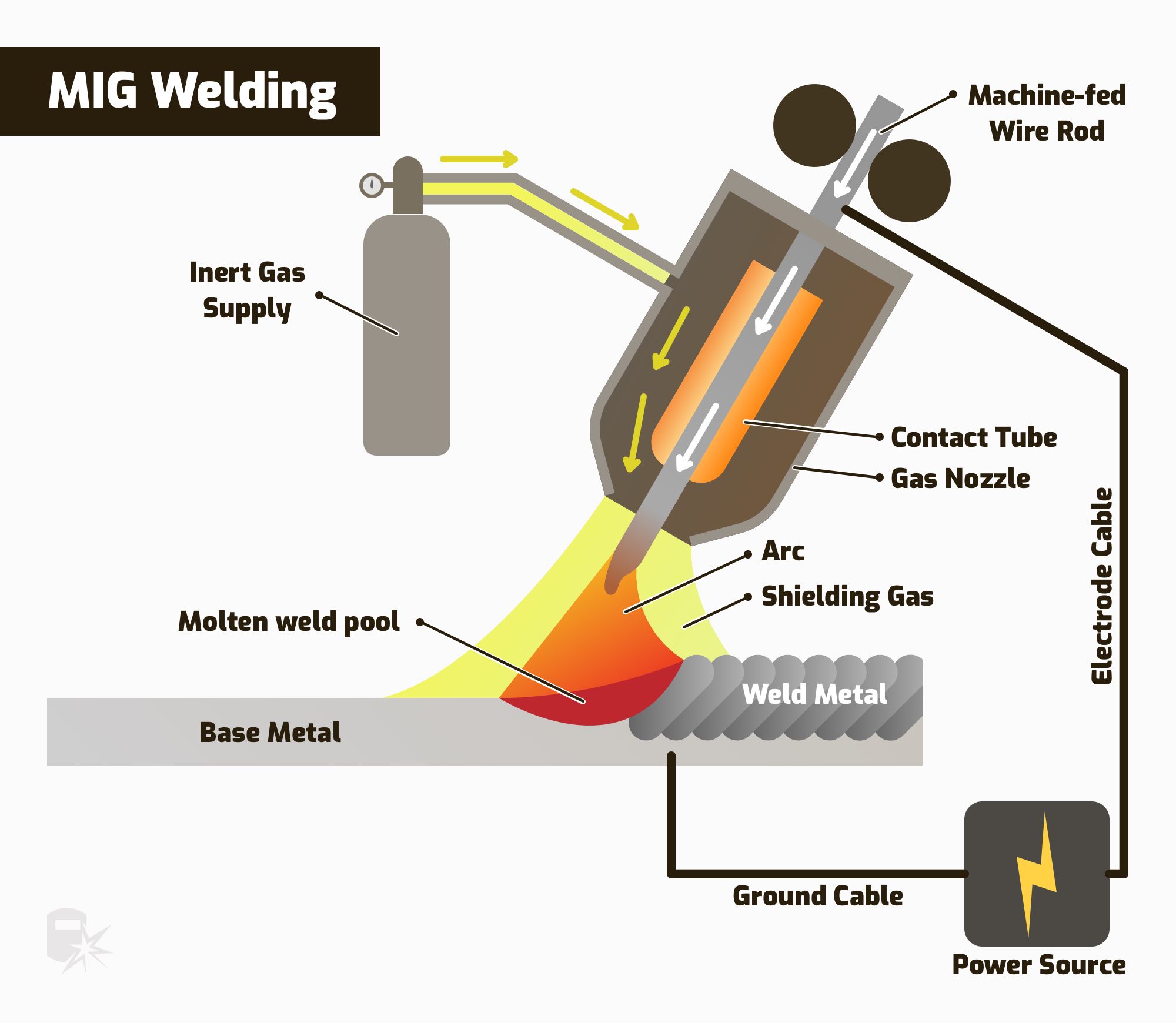
Since the wire electrode also serves as the weld filler material, the wire diameter and composition will vary. Which you use depends on variables like the type of metal, its thickness, and the joint configuration.
The solid electrode wire comes on different size spools, and the MIG welder feeds it to the torch, where it is consumed. Therefore, one of the key MIG welder settings is the wire feed speed (WFS), which must be set to provide the right amount of weld metal for the intended joint.
Also, the shielding gas used is often a blend of 75% argon and 25% CO2. This blend promotes weld penetration and reduces the porosity of the bead. But depending on what you are welding and other variables, the shielding gas can differ.
For more details on MIG welding, please refer to my article on the MIG welding process.
TIG Welding Process
Tungsten inert gas (“TIG”) is sometimes also referred to as gas tungsten arc welding (“GTAW”).
The TIG welding process also uses an arc to weld. But a key difference between MIG and TIG welding is that it uses a non-consumable tungsten electrode and a separate consumable filler material.
You must manually feed a “rod” of filler material into the weld puddle with your second hand while the non-consumable tungsten electrode produces an arc.
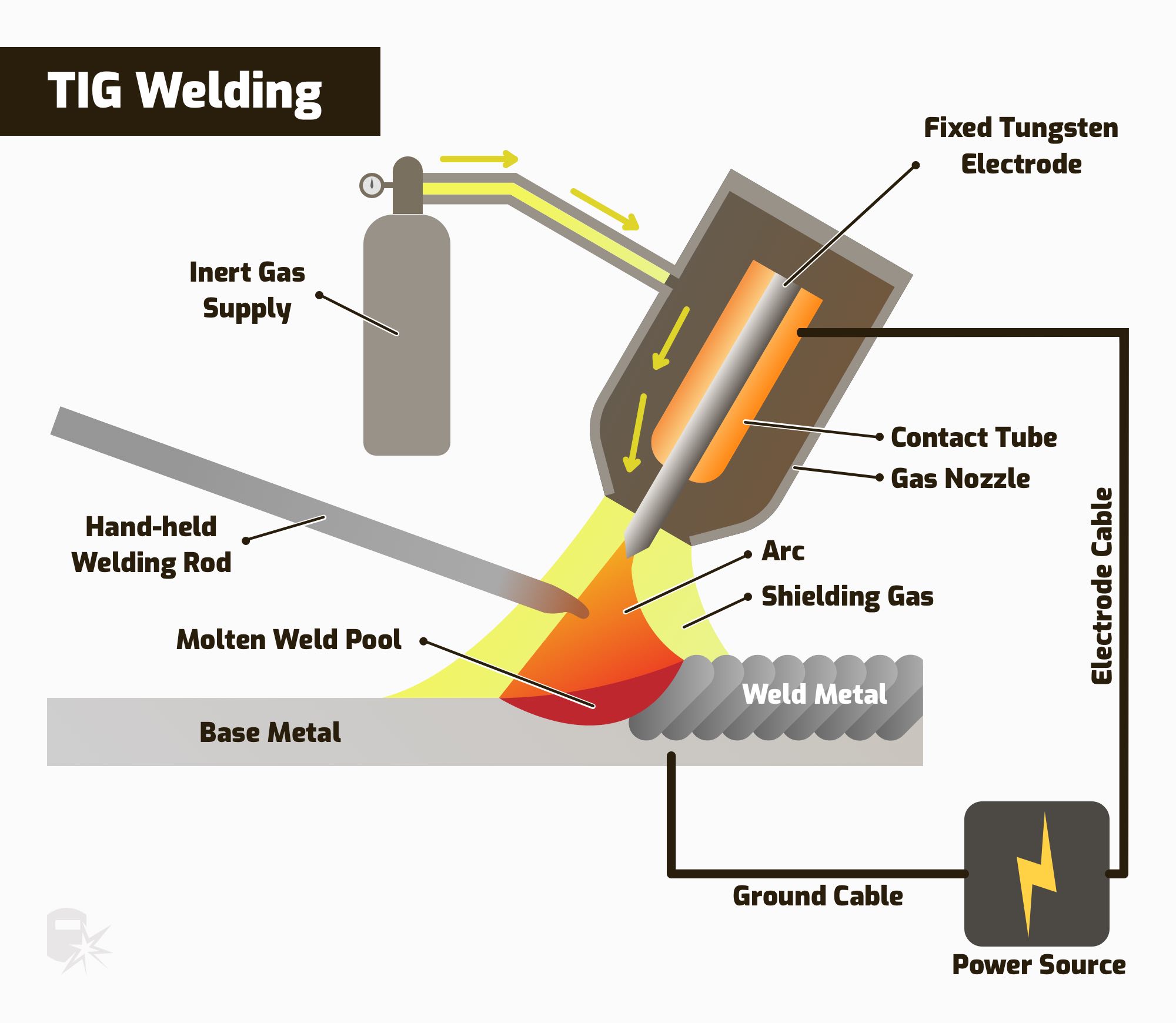
Just as with the consumable MIG wire electrode, the TIG filler rod composition and size will vary depending on the specific weld you are doing.
The TIG welding shielding gas is typically 100% argon and not the argon/CO2 blend used in MIG. CO2 promotes tungsten oxide formation, and tungsten oxide prematurely wears down a tungsten electrode. Plus, it adds tungsten oxide contaminants into your weld.
While not shown in the diagram, you often have a foot pedal to tweak the amperage as you weld. This means you can change the heat while you weld, giving welders precise control over the heat introduced to the metal.
For more details on the TIG welding process, please see my GTAW welding guide.
MIG vs. TIG Welding Differences
As you can see from the brief explanation of the two processes, there are major differences.
But how does that impact the weld?
More than you might think… Let’s take a closer look at some of the important weld characteristics.
Weld Strength
TIG welded joints are considered stronger than MIG welds. This is because TIG welders produce a narrow, focused arc that is better at penetrating the metal.
Also, TIG beads done right are clean and usually contain few defects like holes in the bead. Defects weaken a weld, so fewer of them mean a stronger joint.
Based on the observed penetration and the small number of visual defects, many will say that means properly done TIG welds are stronger. And there is considerable truth to that claim.
However, that may be an oversimplification. Both methods can produce strong, durable welds. Plus, you can take measures to get better penetration and strength with a MIG welder.
Cutting or grinding a V groove into a joint before welding increases penetration. Also, a good torch position and travel speed can help to create a strong MIG weld.
When MIG welding is done properly, the strength often meets or exceeds the strength of the base metal.
Weld Speed
For production, MIG welders offer better speed. You can read more on the uses of MIG welding here.
TIG welding produces clean, good-looking welds, but at a price. TIG welders cannot move the weld puddle and supply enough filler rod as fast as a MIG welder.
Also, when TIG welders run during lengthy welds, air-cooled torches get too hot. This then means switching to a more expensive and complex water-cooled torch.
In contrast, the electrode/filler material is fed automatically with a MIG welder, and its arc is rounder and broader, dissipating heat better.
These attributes allow workers to move the puddle faster when working with a MIG welder and make longer runs with an air-cooled torch.
It is no secret that larger operations want welding units that can run for long periods of time and easily create yard after yard of weld beads.
For this reason, quality MIG welders are often the welder of choice in industrial shops that require high production.
Welding Gas
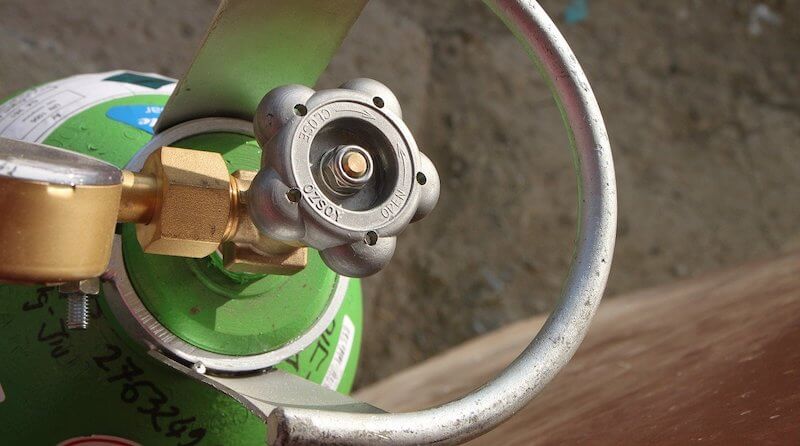
A shielding gas keeps reactive gases found naturally in the air away from the weld puddle. They cause impurities in your weld, so shielding gas is important for a quality weld.
But the shielding gases commonly used in the MIG and TIG processes are different.
TIG welds often use pure argon gas. The tungsten electrode is more sensitive to reactive gases like CO2 and oxygen, so a non-reactive gas like argon is a must.
However, a blend of argon with other gases like helium, nitrogen, or hydrogen may be needed for special applications.
In contrast, MIG welders commonly use a blend of argon and carbon dioxide (e.g. 75% argon, 25% CO2). The small amount of CO2 provides better penetration and stabilizes the arc. (Read more on gases used for MIG welding)
However, the MIG gas differs for specific applications. For instance, when MIG welding aluminum, you need to use 100% argon. Or, MIG welding with pure CO2 is possible, which is cheaper and increases weld penetration (even though there are some disadvantages).
Another aspect of using a shielding gas, is the flow rate must be properly set.
A MIG weld typically uses 35 to 50 cubic feet per hour. In contrast, a TIG welder shielding gas flow of 15 to 25 cubic feet per hour will cover most applications.
Weld Aesthetics
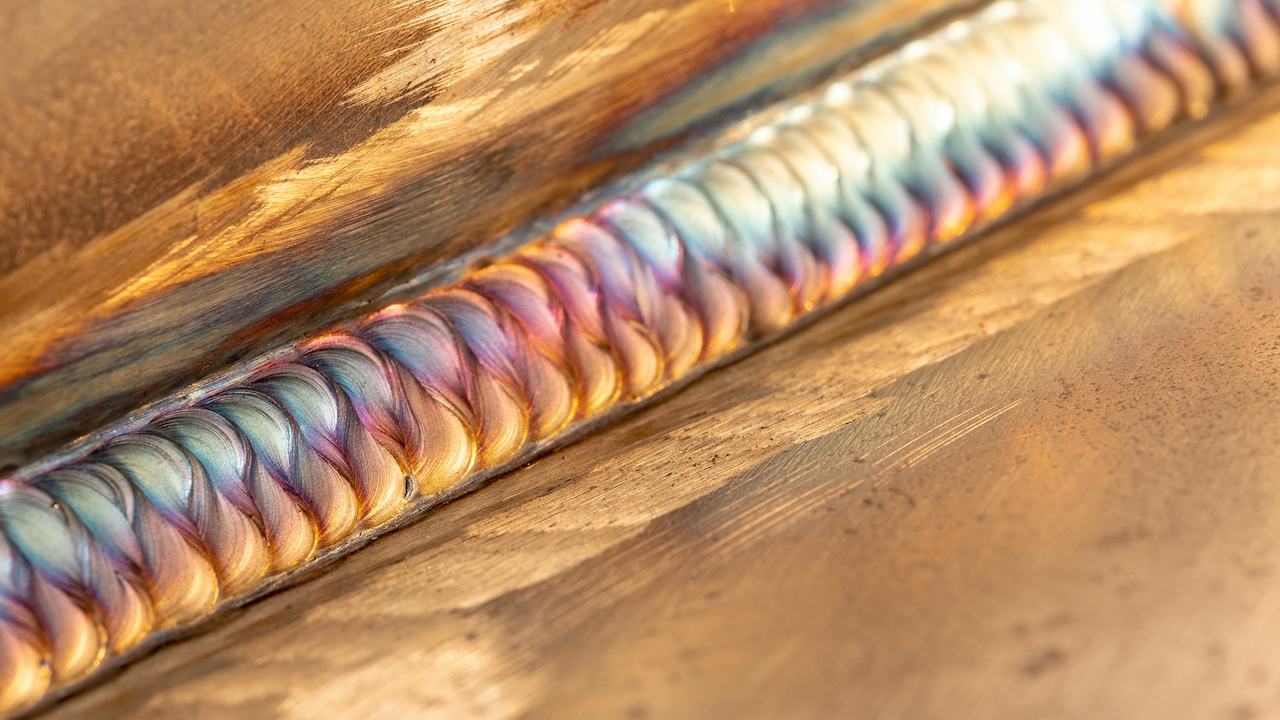
Beads properly created by a TIG welder are clean and professional in appearance. They rarely create spatter and typically only require light polishing (or pickling) to remove any discoloration.
Neatly “stacked dimes” left by a good TIG welder are considered by many to be the standard for an aesthetically pleasing weld. So, TIG welding holds an edge over MIG welds when it comes to looks.
Related Read: TIG Welders – Our Top Picks
When the piece is not coated or painted, as is often the case with aluminum and stainless steel, TIG beads are usually used to make the finished piece more pleasing to the eye.
That is not to say good MIG welds are ugly. An experienced welder can lay good-looking beads with a MIG welder. Plus, for many projects, a picture-perfect weld is not needed, and a MIG welder may be able to produce beads that meet the project’s aesthetic needs.
Also, steel welds are often coated. So, the weld appearance is less important since, as they say, “paint hides many sins.” For this reason, it is common to MIG weld steel that is to be painted.
Weldable Metals
Stainless steel
Unlike mild steel, stainless steel (“SS”) retains heat efficiently. This causes SS to warp at high temperatures, and sometimes it distorts as it cools.
This makes SS more difficult to weld, especially for novice welders. However, the precise heat control offered by a TIG unit lets welders tweak the heat with a foot pedal. With experience, this means the operator has better control.
Plus, TIG welds are narrow and precise because of the tight, focused arc from a TIG torch. This makes it a good choice for thin SS material or fine work.
So for multiple reasons, including finished appearance, most SS welds are done using a TIG welder.
When TIG welding SS, It is not uncommon for the argon shielding gas to be a blend of argon with helium and/or nitrogen. But the shielding gas can vary, depending on the specific SS alloy being welded.
However, there are times when MIG welding SS with a pulsed current may be a better choice. For example, MIG welding might be more appropriate if you need high production rates, welding out of position, or dealing with a complex joint.
Aluminum
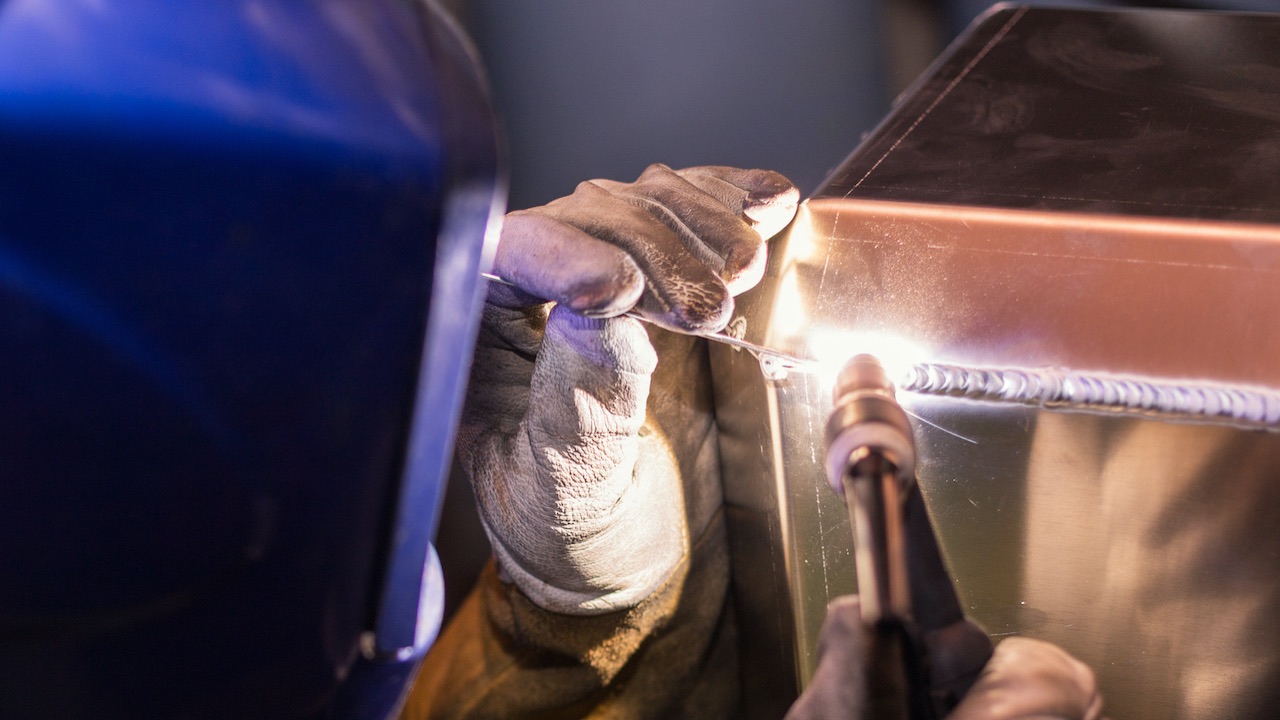
Welding aluminum presents a different challenge as it conducts heat very well. Also, a natural layer of aluminum oxide forms on aluminum almost immediately when exposed to air, disrupting the arc. Both of these make aluminum harder to weld.
So, good heat control and care to establish a good ground are a must, as well as an arc that can cut through the aluminum oxide. The precise control offered with a TIG foot pedal is a significant benefit to controlling your heat with a material like aluminum.
The TIG process also uses an alternating current (AC) which better cleans this pesky layer of aluminum oxide found on the surface, as opposed to DC welding. This is unique to TIG welding, which is an important reason why TIG is a good choice for welding aluminum.
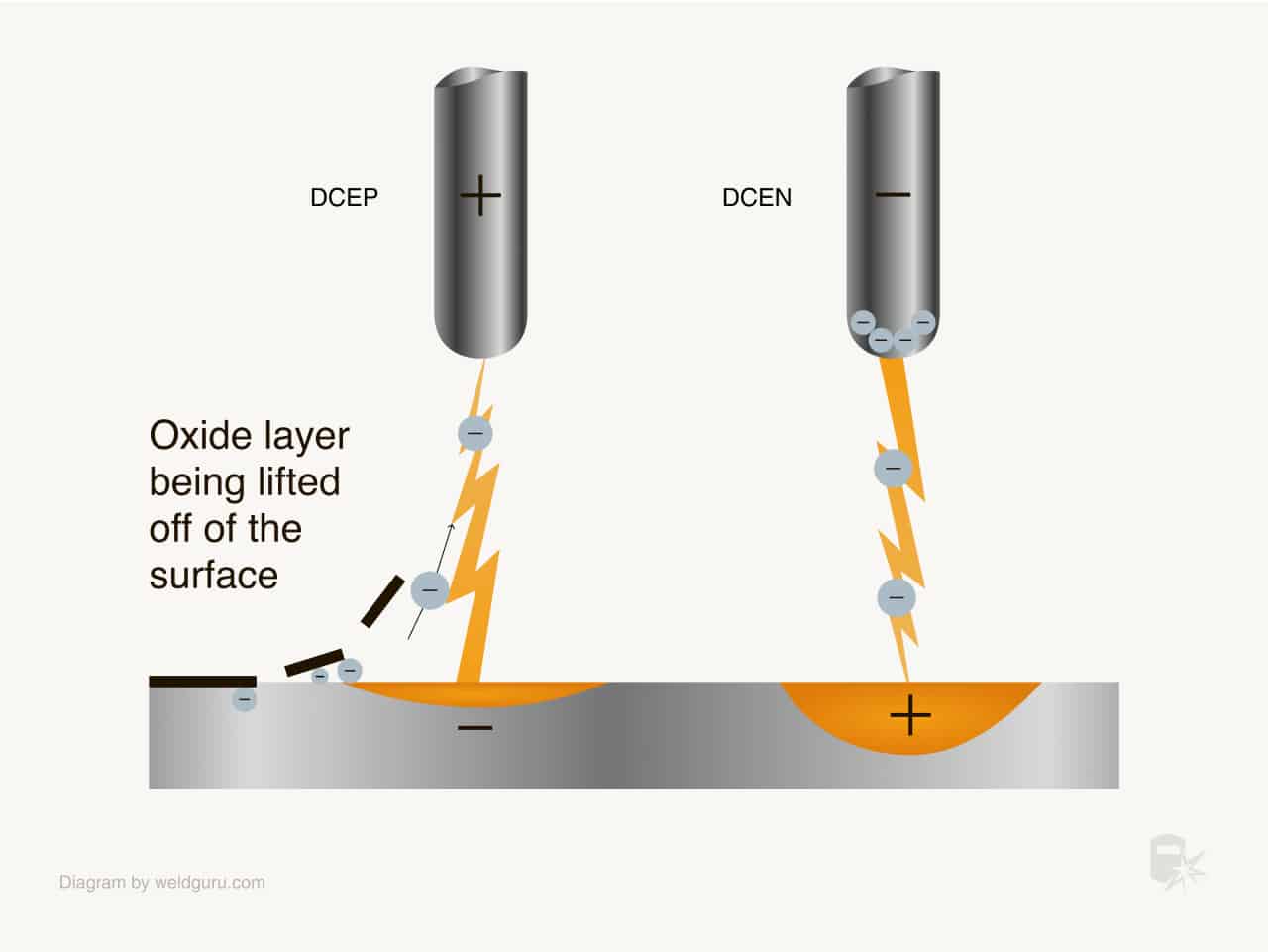
Also, like SS, aluminum is often left uncoated. That means the clean, neatly stacked “dime” TIG beads may be needed to achieve the desired appearance.
But MIG welding of aluminum can be done. It is more susceptible to atmospheric gas contamination and defects caused by small amounts of dirt or moisture. So, you must clean and prepare the metal well and be sure your aluminum feed wire is fresh, clean, and dry.
Another issue with MIG welding aluminum, you will deal with issues feeding the soft aluminum wire to the torch. Some use a spool gun to minimize bird nesting and wire tangles for this reason.
But once all the precautions are in place, you will be able to move more quickly and be more productive using a MIG welder when working with aluminum.
Difficulty to Learn
TIG welding requires you to move the torch with one hand and feed the filler rod with the other hand. Also, you often control your amperage during the weld with a separate foot pedal. This requires some practice to master all these simultaneous movements.
Don’t forget the metal must be cleaned and prepped meticulously. TIG welding creates quality beads when done properly. That is an important caveat. TIG welding is not forgiving if you cut corners, and you will have to deal with poor or even failed joints.
For these reasons, TIG welding is more complex and takes more time to learn. It is not uncommon for welders to consider TIG welding as a more advanced, expert level.
So, all that should mean MIG welding is easier to pick up, and it is. There is no foot pedal to worry about, and the filler material is fed automatically by the machine.
Plus, MIG welders are versatile. They deal with thick materials better than TIG, so learning on a MIG welder exposes workers to more kinds of work. Plus, you can do all this with only one hand.
To start the arc, you just pull the MIG gun trigger. For this reason, MIG welders are sometimes called the “hot glue gun” of welding.
Workers can easily learn the process, get good productivity, and make quality MIG welds faster than learning the more complicated TIG process.
Cost
The slow nature of TIG welding and the lower deposition rates make the TIG cost per foot of bead more expensive. It also means an experienced welder is needed to do the work, which is more expensive.
Also, the initial cost of a TIG welder is usually higher too. Consumables are usually more expensive, but not by much, if at all.
In contrast, a MIG welding unit usually costs less than a TIG welder. In addition, the speed advantage of MIG welding makes the cost per foot of installed bead lower, too. Plus, less prep work is needed compared to TIG welding.
For these reasons, MIG welds are invariably produced at a lower cost than TIG welds.
When To Use TIG and MIG Welding
MIG Applications
The MIG process has some advantages. That means there are times when MIG welding will be your best choice.
Some instances where you would use a MIG welder include:
- Thicker Stock: The fast, productive MIG process will be a better choice when a job calls for welding thicker material or bigger pieces. The continuous feed wire will be more productive than the TIG hand-fed rod at providing a large amount of filler material needed.
- Long Runs: Where there are numerous long runs, the MIG process can handle the situation with its continuously fed wire. Also, the TIG process requires many stops and starts to get new rods or adjust the rod in your hand. This increases the chance of creating a weld defect in a long bead.
- Difficult Positions: Since you only need one hand to run a MIG torch, you have a free hand to balance yourself or to hold pieces.
- Production: MIG can create more feet of beads in an hour than TIG and install more “pounds” of weld filler. When high productivity is needed, MIG welding is the go-to method.
- Less Experienced Welders: MIG welders with lesser experience can lay good beads on a project with the easier-to-learn MIG process. But they may not be able to do so with a TIG welder.
TIG Applications
TIG welding will be a better choice when you are dealing with the following:
- Thin Material: TIG welds are better for thinner metals that are susceptible to warping and burn-throughs because they can produce precise and clean welds compared to MIG.
- Experienced Welders: TIG welding is harder to learn, but if you or your employees have the experience, it allows you to use TIG welds when it is the better welding process.
- Non-Ferrous Metals: For metals like aluminum, SS, copper, and other exotic metals, TIG welding is often the first choice for experienced welders. But it will not work on cast iron, which is ferrous.
- Bench or Shop Work: TIG will not work well when you are out of position. But for bench or shop work, you normally are not out of position. This makes this work a good candidate for TIG welding.
- Short Runs: TIG welding works best in short runs, such as pipe joints.
- Fine or Delicate Work: TIG is often the go-to welding method when the final piece must look great. Pieces like artwork, automotive restoration, sinks, etc., that are highly visible are prime TIG applications. Plus, you have the heat control needed to prevent warping and burning with thinner, finer pieces of metal.
Related: What Can You Weld With a TIG Welder?
Conclusion
Neither TIG or MIG is “better.” One may be a better choice in certain situations, depending on the variables you must address.
MIG welding offers a lower cost and fast welds on steel and aluminum. Stainless steel can be welded, too, but it is not the primary use for MIG welders. For low-cost and high-production, MIG welding is a good choice.
TIG welders create accurate, narrow, good-looking beads with good penetration. But they are more expensive and require experienced welders. The TIG process is often preferred for pipe joints, thinner stock, and on aluminum and stainless steel work where the bead is left exposed.
Steel can be TIG welded, too. But MIG is often a better choice when the steel is to be coated or aesthetics are not a high priority.
Another process to take a look at is Stick welding (Shielded metal arc). We break down the differences between MIG vs Stick welding in this article here.
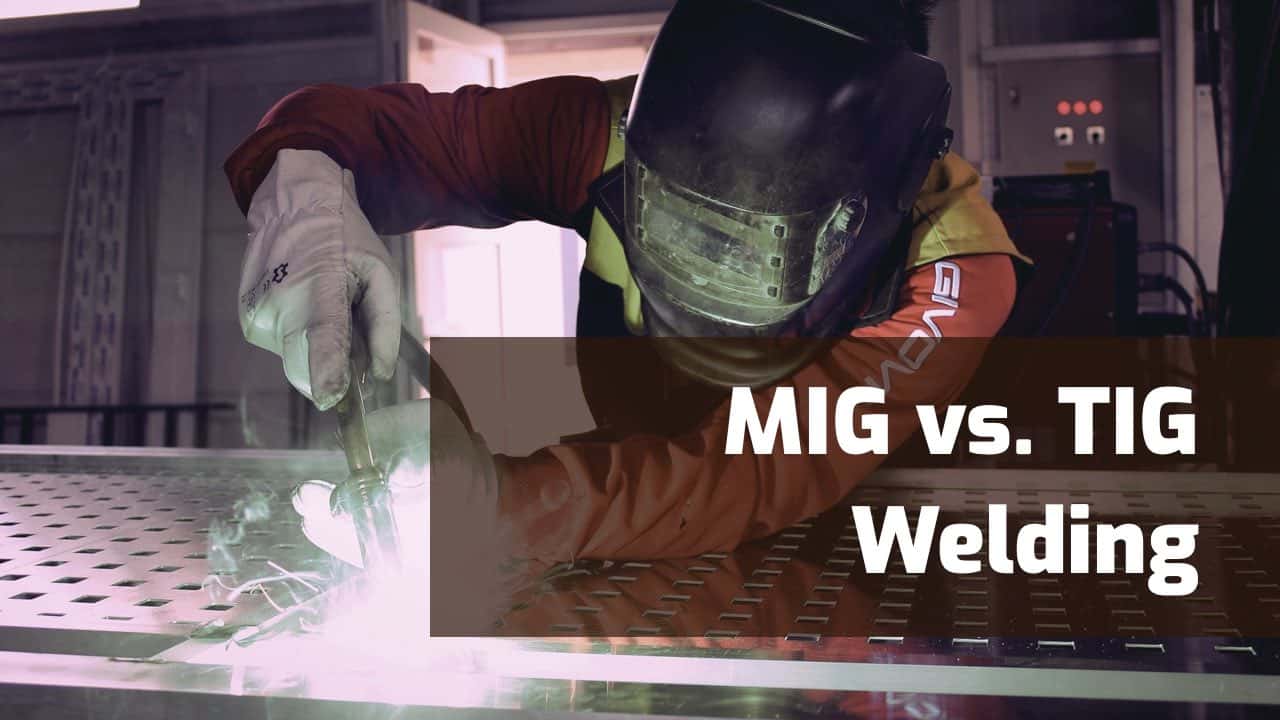
I’m an experienced TIG welder, mostly working on thin gauge steel. I was hoping to learn the differences between MIG and TIG that would build on that TIG experience. Here are the questions I came in with that I still have: 1) how do the amperage of MIG and TIG compare for the same job? 2) how does visibility of the welding puddle and arc differ between MIG and TIG? 3) can you slow MIG down enough that it is similar to TIG and you can do very precise welds?
Thanks for the questions David. I will make sure to answer these in the next round of edits. It would be too much to go in to in the comments here.
1. TIG uses less amperage because the torch temperatures are higher.
2. The puddle is more difficult to see with TIG because the torch is bigger, bulkier and often stands off higher.
3. Welding is a craft. Some craftsmen can run MIG sharp enough with the right box, electrode wire and settings.
Thanks for the additional differences! I will try to add them in the next round of edits.